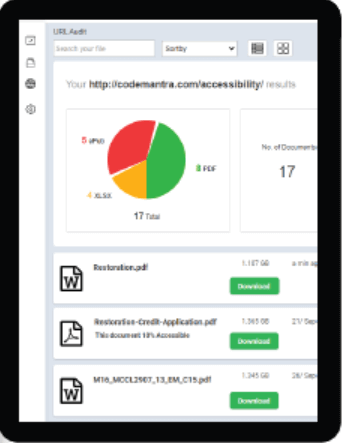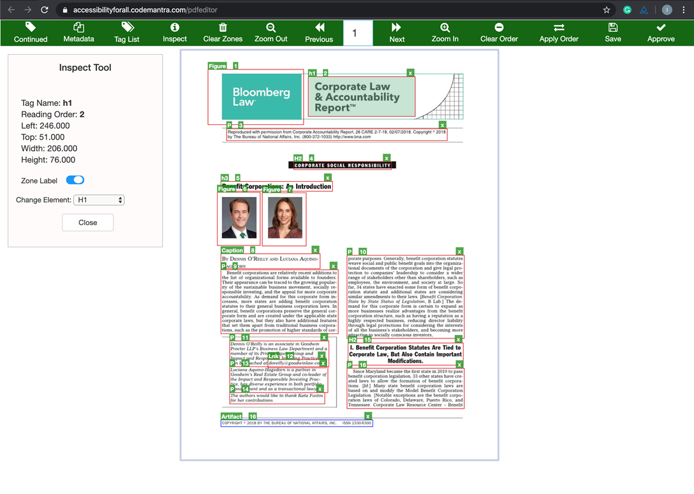Introduction
Educational institutions and government agencies face challenges in making their digital content accessible to people with disabilities. With the increase in emerging technologies, organizations often look for the perfect accessibility solution, which impedes progress.
Disability data
- Approximately 7 million people in the United States have a vision disability
- Approximately 15 million people live with a cognitive disability
- Close to 10 million people are dyslexics
Digital Accessibility Laws
The Americans with Disabilities Act, Title II
The ADA requires State and local governments to provide qualified individuals with disabilities equal access to their programs, services, or activities, unless doing so would fundamentally alter the nature of their programs, services, or activities or would impose an undue burden on them.
Web Content Accessibility Guidelines 2.0
Web Content Accessibility Guidelines (WCAG) 2 was developed to provide a single shared standard for web content accessibility (information in a web page or web application, including text, images, etc.) that meets the needs of individuals, organizations, and governments internationally.
Section 504
Section 504 is a federal law designed to protect the rights of individuals with disabilities in programs and activities that receive Federal financial assistance from the U.S. Department of Education (ED). Recipients of this Federal financial assistance include public school districts, institutions of higher education, and other state and local education agencies.
Section 508
Section 508 requires Federal agencies to make their electronic and information technology accessible to people with disabilities. The 508 technical standards apply to software and operating systems, intranet and internets, computers, and other technology products used by federal agencies.
Accessibility is not a race but a slow walk
When it comes to accessibility, take that first step. The trick is to start. Even if you launch a new website or update a web page, ensure any new content you add is accessible. Add alt text to images in your blog, upload accessible PDFs with proper headings and tables.
Progress not perfection for visually impaired online users
People with disabilities use a screen reader to navigate the web and digital content. But a screen reader is of no use if the website or digital document is inaccessible.
For example, a student who is visually impaired may visit the website of his college/university looking for information about online classes. But if the website is not navigable by keyboard and does not have the information in an accessible format, the student will not be able to attend his classes on time.
Accessibility takes time. Organizations can make progress in making websites and content accessible and still make information available to the public.
Problems in the pursuit of perfection
Missing alt text: Most of the images online, on websites, digital content, and on social media have missing alternate text or alt text. People with disabilities find it difficult to understand the context of an image without an accompanying description. Organizations can take small steps towards progress by providing alt text to images online.
Missing button and link text: Missing hyperlink text rank poorly on search engines. One way to boost SEO is to provide descriptive text for links and buttons. Instead of saying ‘Click here’ or ‘Learn More’, it is more useful to provide descriptive labels like ‘Click here to register for the webinar.’
Missing captions: People with hearing impairments find it difficult to consume videos without captions online. Get started with captions in a small way by turning on automatic captions. You can always edit them later. Make an effort to add closed captions to all your videos.
Take the captions pledge and show that you will add captions to all your videos from now on.
Inaccessible digital content: Screen readers used by people with disabilities cannot navigate inaccessible PDFs, Word, Excel and other digital documents. Inaccessible PDFs can be made accessible by tagging them with proper heading levels, setting the reading order, and adding meta-data information.
About codemantra
codemantra is a leading Intelligent Document Processing (IDP) Solutions Provider. Its AI-driven platform automates digital document accessibility compliance; captures, classifies, and extracts data; and transforms documents into any output format.
Email us: engage@codemantra.com or call us at: 1 (800) 769-9715
How emerging technologies like accessibilityCheck and Fix enables progress?
accessibilityCheck and Fix enable progress of time sensitive material of pre-existing content which is cost effective and time saving.
accessibilityCheckTM is a cloud-based multi-document audit and compliance report module that performs a comprehensive audit of PDFs and documents in other formats such as Word, Excel, etc. The documents are assessed for accessibility compliance against PDF U/A and WCAG 2.1 Level AA accessibility standards.
The cloud-based service provides robust accessibility compliance reporting against PDF U/A and WCAG 2.1 Level AA guidelines to assess document accessibility errors and where remediation steps need to be taken to become compliant.
A screenshot shows the detailed compliance report for various document formats, PDF, e Pub, and Excel.

A screenshot shows pass, fail, and warning errors in a detailed compliance report for all four document formats – PDF, Word, Excel, PPT

Features
- 100+ automated compliance tests against PDF/UA standards and WCAG 2.1 guidelines.
- Provides validation output in JSON or HTML format.
Benefits
- Comprehensive audit and assessment: Comprehensive audit of digital documents in any format and performs 100+ automated compliance tests against PDF/UA standards and WCAG 2.1 guidelines.
- Compliance report: Semi-interactive HTML report shows the accessibility errors in a detailed compliance report along with the PDF/UA or WCAG criteria that it fails against.
- Integration: Easily integrates into any business application or platform through a REST API.
- Speed: Rapid generation of compliance report within minutes.
accessibilityFixTM is an automated PDF accessibility remediation module. It allows the AI-powered creation of document structure, extraction of metadata, and automated tagging without human intervention to achieve compliance with federal ADA and Section 508 laws as well as state laws.
The module uses AI-engine to auto-predict zoning tags for headings, paragraphs, tables, lists, and images. It then groups the elements and arranges them in a sequential order. The alt text for the images can be provided by the user and saved on the platform.
The accessibility validation log is generated containing the summary of warnings, errors, and success data along with the alt text, document properties, and document structure.

The document on the left has a perceived structure to the sighted and presents a logical reading order. The screenshot on the right shows codemantra’s automated remediation tool which auto-tags the document so that assistive technologies can leverage the imposed structure and provide a logical reading order.
Features
- 100% AI and machine learning-powered automated remediation without human intervention
- Provides auto-generated syntactic alt text and MathML for equations
- Flexible licensing models allow customization of the solution
Benefits
- Seamless integration: Easily integrated into any business application or platform workflow
- Accuracy: Accurate accessibility remediation of PDFs in accordance with PDF/UA standards
- Turnaround time: Reduces the time to make PDFs fully accessible
Why accessibilityReview is the perfect solution?
accessibilityReview™ enables the interaction between automated AI-engine and humans to create accessible digital content to benefit people with disabilities.
The cloud-based SaaS platform has an intuitive UI that allows users to perform validation across all document types to comply with WCAG 2.1 guidelines, add enhanced meta-tagging, enter custom alt-text, and generate compliance report.

Features
- Audit & assess corpus of digital documents
- Generate assessment reports
- Impose structural tags to ensure intelligent content reflow
- Create and edit alt text for visuals & graphics
- Recompile and validate content against PDF/UA & WCAG 2.1 Level AA guidelines
Benefits
- Validation: Comprehensive manual validation across all document types to comply with PDF U/A standards WCAG 2.1 guidelines.
- Compliance report: Users can generate document compliance report.
- Human-assisted intervention: Users can write and review alt text descriptions for images, review auto-generated math descriptions, and review the semantic structural elements in the documents to optimize accessibility.
Final Thoughts
Many organizations resort to taking content off the websites entirely because of time constraints and spiraling costs because of their emphasis on perfection. It is possible to make progress in accessibility and still make information available to the public. All it takes is taking that first step and moving forward.







